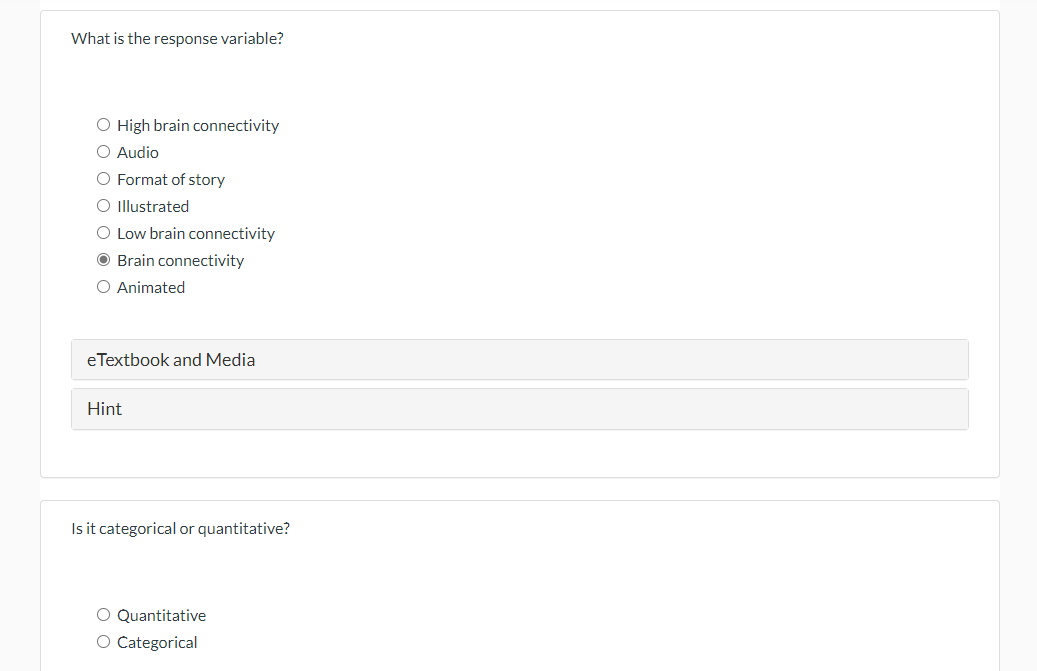Goldilocks Effect: Read to Your Kids! The American Academy of Pediatrics recommends that parents begin reading to their children soon after birth, and that parents set limits on screen time. A new study¹ reinforces these recommendations. In the study, 27 four- year-olds were presented with stories in three different formats: audio (sound only), illustrated (sound and pictures), and animated (sound and animation). During the presentations, a magnetic resonance imaging (MRI) machine measured each child's brain connectivity. The researchers found a "Goldilocks effect," in which audio was too cold (with low brain connectivity as the children strained to understand) and animation was too hot (with low brain connectivity as the animation did all the work for the children). The highest connectivity (just right!) was found with the illustrated format, which simulates reading a book to a child. 1. Hutton J et al., "Differences in functional brain network connectivity during stories presented in audio, illustrated, and animated format in preschool-age children," Brain Imaging and Behavior, October 30, 2018.
Goldilocks Effect: Read to Your Kids! The American Academy of Pediatrics recommends that parents begin reading to their children soon after birth, and that parents set limits on screen time. A new study¹ reinforces these recommendations. In the study, 27 four- year-olds were presented with stories in three different formats: audio (sound only), illustrated (sound and pictures), and animated (sound and animation). During the presentations, a magnetic resonance imaging (MRI) machine measured each child's brain connectivity. The researchers found a "Goldilocks effect," in which audio was too cold (with low brain connectivity as the children strained to understand) and animation was too hot (with low brain connectivity as the animation did all the work for the children). The highest connectivity (just right!) was found with the illustrated format, which simulates reading a book to a child. 1. Hutton J et al., "Differences in functional brain network connectivity during stories presented in audio, illustrated, and animated format in preschool-age children," Brain Imaging and Behavior, October 30, 2018.
Glencoe Algebra 1, Student Edition, 9780079039897, 0079039898, 2018
18th Edition
ISBN:9780079039897
Author:Carter
Publisher:Carter
Chapter10: Statistics
Section10.6: Summarizing Categorical Data
Problem 27PPS
Related questions
Question
In the same passage, what is the response variable and is it quantitative or categorical?

Transcribed Image Text:Goldilocks Effect: Read to Your Kids! The American Academy of Pediatrics recommends that parents begin reading to their children
soon after birth, and that parents set limits on screen time. A new study¹ reinforces these recommendations. In the study, 27 four-
year-olds were presented with stories in three different formats: audio (sound only), illustrated (sound and pictures), and animated
(sound and animation). During the presentations, a magnetic resonance imaging (MRI) machine measured each child's brain
connectivity. The researchers found a "Goldilocks effect," in which audio was too cold (with low brain connectivity as the children
strained to understand) and animation was too hot (with low brain connectivity as the animation did all the work for the children). The
highest connectivity (just right!) was found with the illustrated format, which simulates reading a book to a child.
1. Hutton J et al., "Differences in functional brain network connectivity during stories presented in audio, illustrated, and animated
format in preschool-age children," Brain Imaging and Behavior, October 30, 2018.

Transcribed Image Text:What is the response variable?
O High brain connectivity
O Audio
O Format of story
O Illustrated
O Low brain connectivity
Brain connectivity
O Animated
eTextbook and Media
Hint
Is it categorical or quantitative?
O Quantitative
O Categorical
Expert Solution
This question has been solved!
Explore an expertly crafted, step-by-step solution for a thorough understanding of key concepts.
Step by step
Solved in 3 steps

Recommended textbooks for you

Glencoe Algebra 1, Student Edition, 9780079039897…
Algebra
ISBN:
9780079039897
Author:
Carter
Publisher:
McGraw Hill

Linear Algebra: A Modern Introduction
Algebra
ISBN:
9781285463247
Author:
David Poole
Publisher:
Cengage Learning

Holt Mcdougal Larson Pre-algebra: Student Edition…
Algebra
ISBN:
9780547587776
Author:
HOLT MCDOUGAL
Publisher:
HOLT MCDOUGAL

Glencoe Algebra 1, Student Edition, 9780079039897…
Algebra
ISBN:
9780079039897
Author:
Carter
Publisher:
McGraw Hill

Linear Algebra: A Modern Introduction
Algebra
ISBN:
9781285463247
Author:
David Poole
Publisher:
Cengage Learning

Holt Mcdougal Larson Pre-algebra: Student Edition…
Algebra
ISBN:
9780547587776
Author:
HOLT MCDOUGAL
Publisher:
HOLT MCDOUGAL